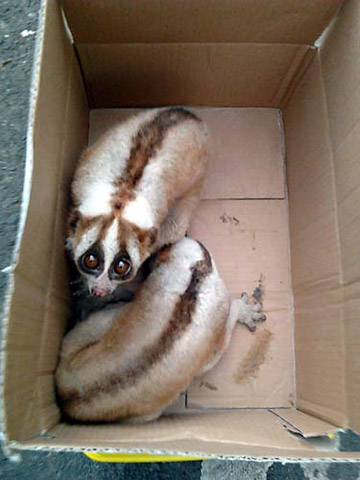
Slow loris photographed in Jakarta market last month. Photo: © TRAFFIC.
Defying Indonesian law, slow lorises are being sold openly in Jakarta markets for the underground pet trade, according to wildlife trade monitoring group TRAFFIC. In the last two weeks, TRAFFIC has recorded fifty different individual slow lorises on sale in the Indonesian capital.
“The openness of the slow loris trade highlights the fact that having one of the region’s best wildlife protection laws and promising to protect species is not enough—there must be stronger enforcement in Indonesia and the public should stop supporting the illegal wildlife trade,” says Chris R. Shepherd, Deputy Regional Director of TRAFFIC Southeast Asia, in a press release.
Slow lorises are big-eyed nocturnal primates found throughout Southeast Asia. Three of the five known species are found in Indonesia: the Sunda slow loris (Nycticebus coucang), the Bornean slow loris (Nycticebus menagensis), and the Javan slow loris (Nycticebus javanicus). The Sunda and the Bornean are listed as Vulnerable by the IUCN Red List, while the Javan is listed as Endangered.
 Slow lorises photographed in Jakarta market last month. Photo: © TRAFFIC. |
The slow loris pet trade has exploded since YouTube videos showed the small primates engaged in “cute” activities. However, researchers warn that slow lorises do not make good pets and that the trade is deeply cruel. Slow loris babies are stolen from their mothers in the wild, who are often killed. The baby’s teeth are removed without anesthetic to make them more “suitable” as pets.
Dr. Anna Nekaris, an anthropologist who specializes in slow-loris research at Oxford Brookes University, told mongabay.com in 2009 that it’s estimated 30-90 percent of captured slow lorises don’t survive the stress of being stolen from the wild.
As pets, slow lorises are unable to clean themselves and are often covered in feces and urine. In addition, due to complex dietary needs pet slow lorises often die of malnutrition.
In one market alone, TRAFFIC counted thirty slow lorises and notes that the animals are on sale daily out in the open.
“The authorities need to clean up these markets and Indonesia’s reputation as a major center of illegal wildlife trade,” says Shepherd.
In addition to the pet trade, slow lorises are also imperiled by deforestation and traditional medicine, which uses slow loris parts for some ailments.
Related articles
“Where’s my mama?”: campaign targets cruel slow loris pet trade [warning: graphic photo]
(03/20/2012) A new campaign by The Body Shop West Malaysia and TRAFFIC Southeast Asia attempts to raise awareness of the illegal slow loris pet trade. YouTube videos of “cute” pet slow lorises have raised demand for these endangered primates, but as the campaign highlights the pet trade is fueling slow loris deaths in the wild and cruel treatment, such as pulling out their teeth, to make them more desirable pets.
Malaysia drops the ball on wildlife trafficking, says group
(02/23/2012) Malaysia failed to effectively assemble a case against convicted wildlife smuggler Anson Wong, leading to his early release from prison, says an anti-wildlife trafficking group.
‘Snakes on a Plane’ trafficker freed early from jail
(02/22/2012) Notorious wildlife trafficker Anson Wong has been freed from prison after a court reduced his five-year term, reports Malaysian state media. Wong had served 17-and-a-half-months for illegally exporting nearly 100 reptiles from Malaysia.
The dark side of new species discovery

(12/21/2011) Scientists and the public usually rejoice when a new species is discovered. But biologist Bryan Stuart has learned the hard way that the discovery of new species, especially when that species is commercially valuable, has a dark side-one that could potentially wipe out the new species before protections can be put in place. Stuart has discovered 27 species unknown previously to scientists – so far. That includes 22 species of frogs, three types of snakes, and two salamanders. His experience with one of these, a warty salamander from Laos with striking markings (Laotriton laoensis), opened his eyes to a dark side of scientific discovery: commercial overexploitation before protections are in place. Shortly after Stuart described the previously unknown species Paramesotriton laoensis in a scientific paper published in 2002, commercial dealers began collecting this Lao newt for sale into the pet trade. In essence, the dealers used Stuart’s geographic description in the paper as a “roadmap” to find the rare newt.
New large horned viper discovered, but biologists keep location quiet

(12/15/2011) In a remote forest fragment in Tanzania, scientists have made a remarkable discovery: a uniquely-colored horned viper extending over two feet long (643 millimeters) that evolved from its closest relative over two million years ago. Unfortunately, however, the new species—named Matilda’s horned viper (Atheris matildae)—survives in a small degraded habitat and is believed to be Critically Endangered. Given its scarcity, its discoverers are working to pre-empt an insidious threat to new species.







